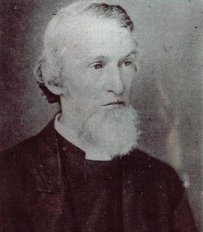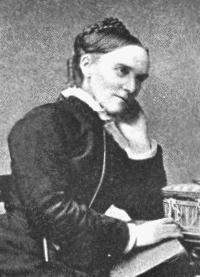History
The Manor of Upton Bishop formed a part of the possessions of the Bishops of Hereford from the time of the Saxon Kings to the accession of Queen Elizabeth 1st.
The Havergal Family

Francis Tebbs Havergal was Vicar of Upton Bishop from 1874. He wrote music, books on the history of Hereford Cathedral and a most comprehensive treatise on Upton Bishop in 1883, entitled “Records Historical and Antiquarian of The Parish of Upton Bishop” .
His sister Frances Ridley Havergal also wrote many books including travelogues, poetry, children’s books, hymns, and religious texts. She died at the early age of forty-two.
A bell was cast as a memorial to her that still hangs in the Church.
Upton Bishop, Herefordshire
Description from Littlebury’s Directory and Gazetteer of Herefordshire, 1876-7
Transcription by Rosemary Lockie © 2003 UPTON BISHOP, WITH CROW HILL, UPTON CREWS, AND PHOCLE GREEN.
UPTON BISHOP is a large parish and village situated on the borders of Gloucestershire, on the upper road between Hereford and Gloucester, and on the main road from Ross to Newent; is distant 3½ miles N.E. of Ross, 5½ W. of Newent, 13 S.E. of Hereford, and 16 W.N.W. of Gloucester; is in Greytree hundred, Ross union, petty sessional division, and county court district, and Linton polling district.
The population in 1861 was 716; in 1871, 716; inhabited houses, 150; families or separate occupiers, 166; area of parish, 3,391 acres; annual rateable value, £5,069. Courtenay Connell Prance, Esq., of Hatherley court, Cheltenham, is lord of the manor. The Right Hon. Lord Ashburton, Lady Lindsay, Mrs. Chellingworth, Thomas Powell, Esq., and William Jones, Esq., are the principal landowners.
The soil is a red loam; subsoil, clay and rock; chief produce, wheat, barley, roots, &c.
Upton Bishop is in the diocese and archdeaconry of Hereford and rural deanery of Ross; living, a vicarage; value, £225, with residence and 202 acres of glebe; patrons, the Dean and Chapter of Hereford; vicar, Rev. Francis Tebbs Havergal, M.A., of New College, Oxford, who was instituted in 1874, and is also one of the chaplains to the Lord Bishop of Hereford.
The church, dedicated to St. John the Baptist, ranks among the most interesting in the county. It was reopened on July 25th, 1862, after having been restored under the superintendence of Mr. (now Sir) George Gilbert Scott, R.A., the eminent church-architect, at an expense of £1,800, raised by voluntary contributions and church building society grants. The church consists of nave, chancel, aisle, porch, and square tower containing an excellent peal of five bells. The pavements are of Godwin’s encaustic tiles. An organ, by Nicholson, of Worcester, was erected in 1874 on the north side of the church, at the sole cost of the present vicar. There are several stained glass memorial windows. The east window is by Hardman; subject, “Jesus appearing to Mary in the garden”, to the memory of the Rev. James Garbett, formerly vicar of the, parish. North chancel, by Wailes; subject, “Zacharias and Elizabeth”, to the memory of Dr. Gretton and his wife, formerly dean of Hereford and vicar of the parish. North nave, by Clayton & Bell; subject, “Raising of Jairus’s daughter”, to the memory of Maude, daughter of the late Henry Chellingworth, Esq., of Grendon court. East aisle, by Hardman; subject, “The Good Samaritan”, to the memory of Mr. Charles Prosser. South aisle, by Hardman; memorial window and brass plate, erected in 1868. South chancel, by Clayton & Bell; subject, “The institution of the Eucharist by our Lord”, to the memory of the Rev. T. B. Power, the late vicar. A brass plate, with inscription, is placed immediately beneath. A beautiful brass tablet (by Hardman) was placed in the church in 1872, to the memory of Henry Chellingworth, Esq., and his son and daughters. The ancient monumental stone in the churchyard has been carefully placed on a slightly raised stone base.
The parish register goes back to the year 1571. There are two schools for boys and girls in the parish, with an average attendance of about 100 conjointly. The Church of England school at Gayton was built in 1871-72 at a cost of £700, the site and stone being given by Lord Ashburton. The Baptist chapel was erected in 1860.
There are several handsome residences in this parish. Just on the edge of the four parishes of Upton Bishop, Ross, Brampton Abbotts, and Weston-under-Penyard, is the old manor-house of Rudhall, once the seat of the family of that name, but now the property of Lord Ashburton, and in the occupation of Miss Mortimer; Grendon Court is the residence of Mrs. Chellingworth and the property of Henry Chellingworth, Esq., of Trimpley, near Kidderminster; Gayton Hall, the Misses Lawson; Manor House, Captain E. Mynde Allen; The Baches House, Captain A. R. F. Onslow; and The Vicarage (which has lately under gone considerable improvement), Rev. F. Tebbs Havergal, M.A.
Crow Hill is a hamlet distant 1 mile W.; Phocle (or Focle) Green is 2 miles S.W.; Upton Crews is near the village.
POSTAL REGULATIONS.-William. Smallman, Sub-Postmaster, Crow hill. Letters arrive by messenger from Ross at 7.50 a.m.; despatched thereto at 5.50 p.m. Money orders are granted and paid, and post office savings bank business transacted. Ross is the nearest telegraph office and post town. The Letter-box, near the school, is cleared at 5.40 p.m.
Parish Church (St. John the Baptist).-Rev. Francis Tebbs Havergal, M.A., Vicar; Francis Hamp Adams, Esq., and Mr. John Powell Bennett, Churchwardens; George Taylor, Parish Clerk; Charles Davies, Sexton.
National School (boys and girls), Upton Bishop.-Miss Sarah Owen, Mistress.
HERITAGE UPTON BISHOP
The “Early Times in Upton Bishop” Project
The “Early Times in Upton Bishop” was a project sponsored by the Local Heritage Initiative (LHI) and Nationwide Building Society. A 50-page, colour A5 book about the project and the findings is now available. For further details contact Jan Stevenson on 01989 780285or email: janstevenson@tiscali.co.uk .
 The project was initiated because of interest in part of a carved stone frieze depicting two figures in adjoining niches which was originally found in 1860 in the wall of the chancel of the Upton Bishop parish church. The LHI project set out to find out more about this history of this stone by investigating the early life of the village. It used archaeological and iconographical studies to place this carving in its historical setting related to the surrounding parish landscape
The project was initiated because of interest in part of a carved stone frieze depicting two figures in adjoining niches which was originally found in 1860 in the wall of the chancel of the Upton Bishop parish church. The LHI project set out to find out more about this history of this stone by investigating the early life of the village. It used archaeological and iconographical studies to place this carving in its historical setting related to the surrounding parish landscape
The principle conclusion is that the stone is potentially unique in forming a link between the earlier Roman and later Hereforshire styles of stone carving. It most probably relates to the first church and the earliest settlement associated with it, in the late Saxon times. In discovering this, a whole panorama of the history of this our south Herefordshire parish unfolds.
The local archaeological work carried out for this project was led by Dr Keith Ray, County Archaeologist for Herefordshire. However, other experts from all across the country were used for specialist advice, research and evaluation. Their input and the support of the Local Heritage Initiative to fund this community enterprise have been essential and highly valued.